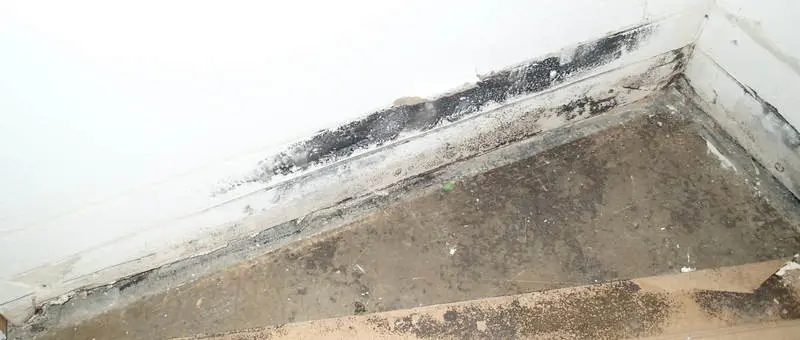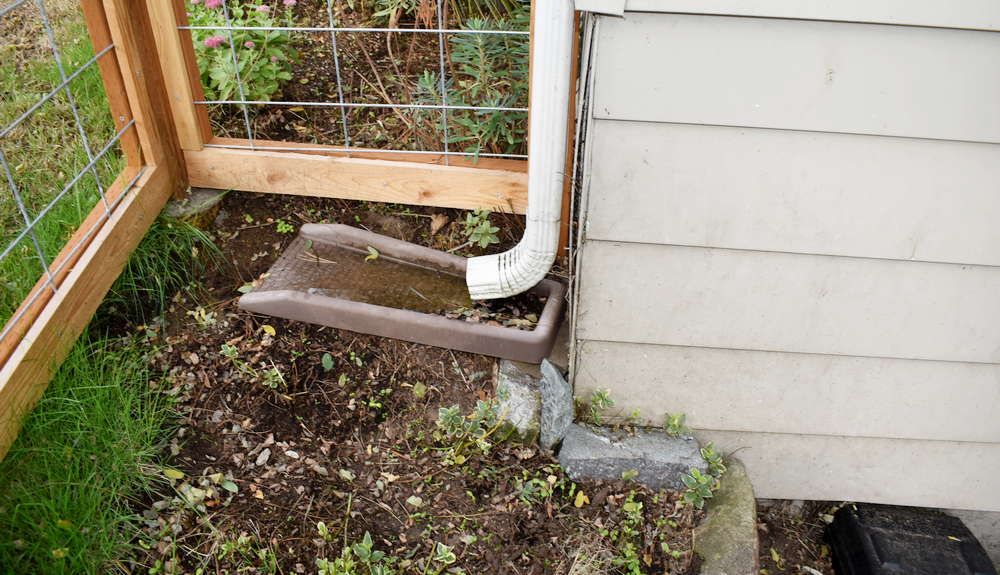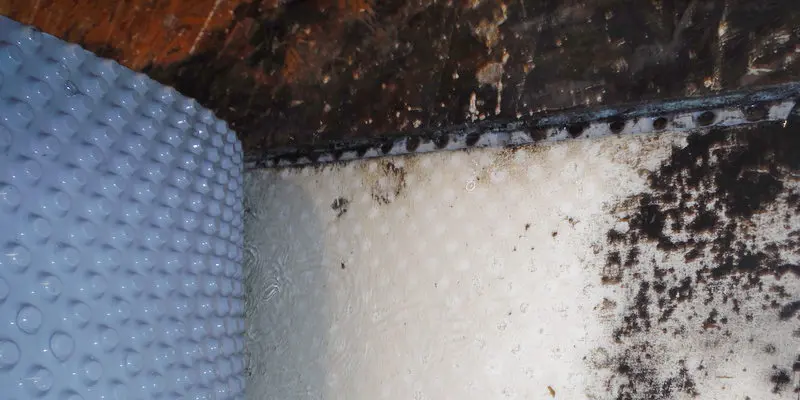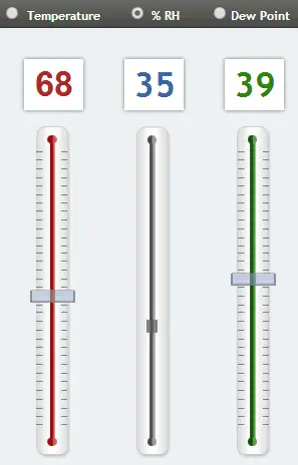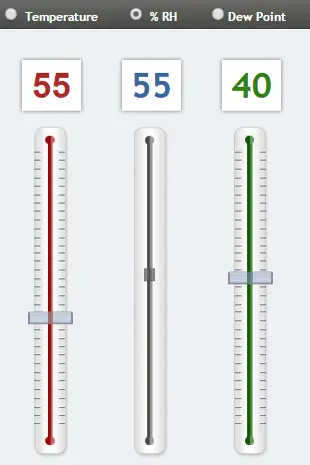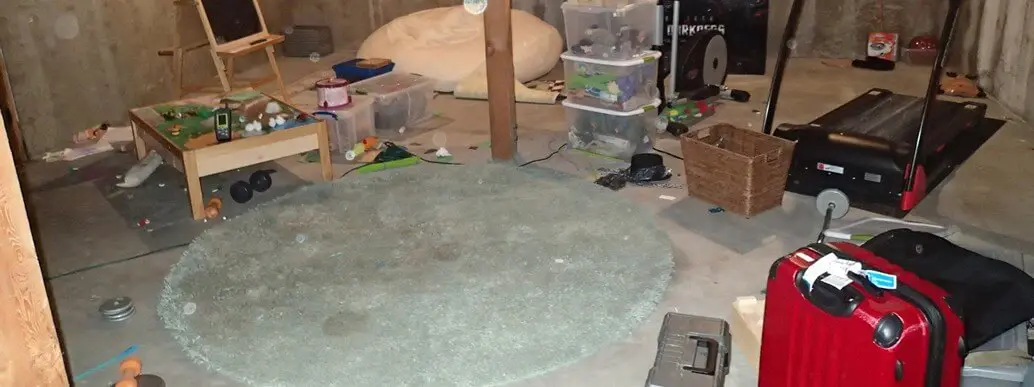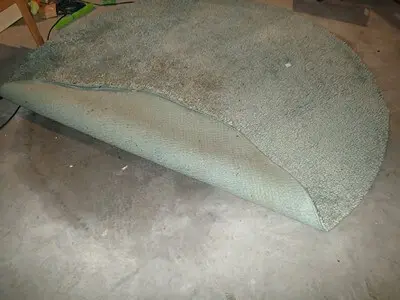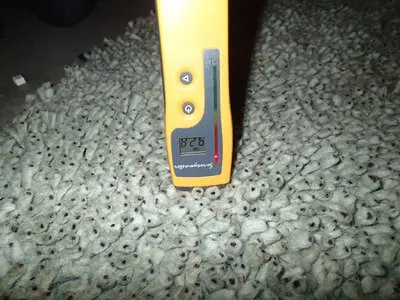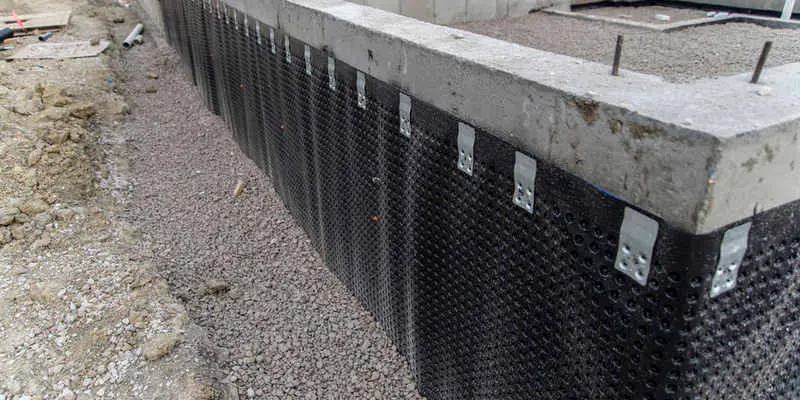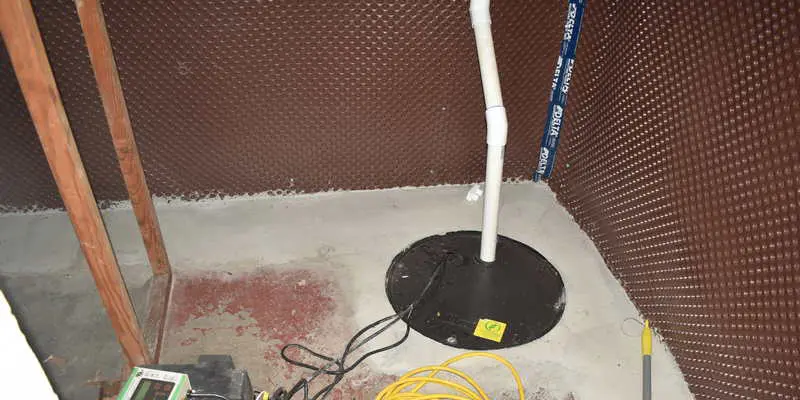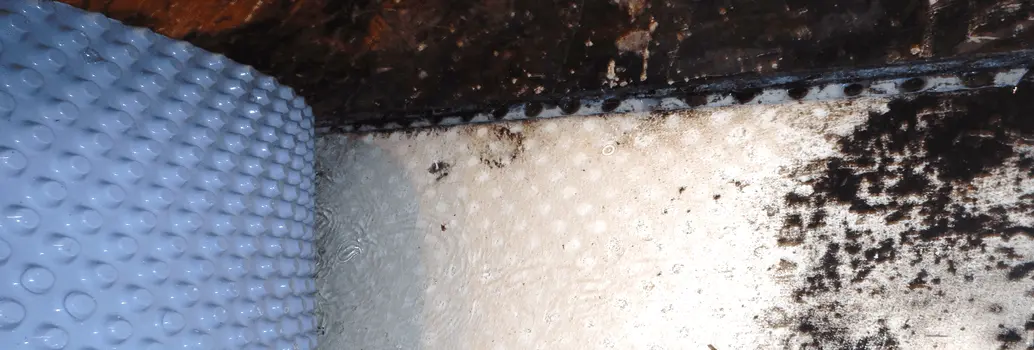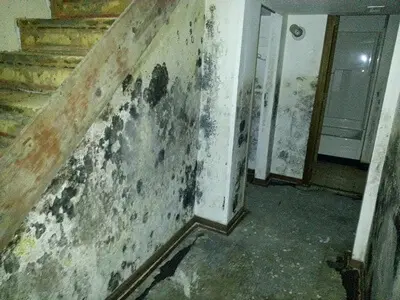MOLD IN BASEMENT | PROBLEMS & SOLUTIONS
How to identify & resolve your basement mold issues
First, identify the moisture source
Mold in the basement is cause by either liquid water or humidity. You must clearly determine which one of these is causing the mold growth before attempting to fix the problem. Let’s look at some common causes of these water issues.
Liquid water intrusions
Leaky cold joint
The cold joint occurs where the concrete slab (floor) meets the vertical foundation wall. Because these are poured at different times, a hairlines crack is present at the joint. If water accumulates in the soil on the other side of this joint, it will eventually flow inward through the crack. This can appear as minor puddling or gallons of water.
Below is an example of mold growth typical of a cold joint failure. You’ll often see heavy mold growth behind the base trim.
Foundation wall
While less common than a leaky cold joint, water can easily enter a basement through the vertical foundation walls. When the surrounding soil becomes saturated, it will take the path of least resistance. Unless the foundation wall is sealed and waterproofed, the water will flow in through imperfections in the wall. Large cracks or holes are not necessary. If the water pressure is sufficient, it will find a way through the wall.
Below is an example of a poorly installed downspout. Leaky foundation walls are often due to this type of setup. Notice how the water is pooling at the base of the diverter, adjacent to the home. Despite all of our technological advances, water still refuses to flow uphill. These downspout diverters accomplish very little, unless the ground already slopes away from the home. Instead, all downspouts should be directed into dedicated 4″ smooth wall plastic piping. Ensure the final exit is a substantial distance from the home.
Interior slab
The least common pathway is through the middle of the slab. Typically this only occurs when there is heavy water pressure, such as a spring, in the middle of the basement. In the image below, dimple board was installed without a working sump pump. This simply creates a pool of water on top of the concrete slab.
Humidity
Excess humidity is common in basements as well. Most homeowners keep the temperature a bit lower in the basement, which causes the relative humidity to increase. When the temperature is lowered, the volume of air shrinks. However, the volume of moisture stays the same. Therefore, as the air cools the ‘relative’ amount of moisture goes up. Because the volume of moisture has not changed, the moisture now occupies a greater percentage of a given volume of air. This is why it’s called ‘relative’ humidity. The actual quantity of moisture hasn’t changed, it’s just become relatively greater in comparison to the air.
Below are two graphs – one showing the typical conditions inside a well ventilated home in the winter. With the temperature at 68F, the RH is down at 35%. This is perfect. Mold would have a very difficult time growing in these conditions. The second graph shows what happens to the relative humidity when you take the exact same air and simply cool it down to 55F. The humidity hits 55%. In climates with damp winters such as Seattle, the starting conditions will likely be significantly higher, which will exacerbate the basement problem.
Basements also have less ventilation than the rest of the home, allowing moisture to build up over time. These factors together can easily cause condensation and mold growth.
The lesson? Keep your basement warm.
Vapor intrusion
Concrete is much more porous than you would imagine. Depending on how it cured and other factors, large quantities of water vapor can pass through the concrete slab. In a basement with bare concrete, the water vapor is absorbed into the adjacent air before any major problems can occur.
Of course, most people don’t want to walk around on bare concrete. Hardwood floors are expensive and risky, so many homeowners opt for carpeting. But now the moisture has nowhere to go. Technically, the moisture can still move through the carpet and pad, but these materials slow the movement dramatically. If the quantity of water vapor is very small, the moisture will eventually make its way into the adjacent air. But once the rate of moisture transport exceeds this dry out ability, mold growth will occur.
Basement with no visible mold growth or flooding
But beneath the carpet? Clear evidence of vapor emissions through the concrete slab
A nearby carpet without a rubber backing showed no signs of moisture buildup.
How can I tell the difference?
Is the mold only growing on the side of the wall facing the room?
This is the most reliable method of distinguishing between humidity and liquid water intrusion. If the mold is growing on the backside of the sheetrock, you are dealing with a liquid water intrusion. If the mold is only growing on the room side of the wall, you’re dealing with condensation.
What if I don’t want to cut a hole in my wall?
Solutions
Exterior waterproofing
Interior footing drains
These systems work by collecting the water on the inside of the foundation wall and directing it toward a sump pump. Think of it as a french drain, but inside the basement instead of in the soil. When installed after the construction of a home, a small trench is cut/dug out of the concrete directly adjacent to the exterior wall. Perforated drain pipe is installed, which directs the water back toward the sump pump. Dimple board, the brown wall covering shown in the photo below, grabs water entering through the foundation wall and directs it down toward the footing drains. These systems are very effective and often more reliable than french drains.
Why basements are problematic
Basements are prone to musty odors and mold growth. This isn’t surprising. If you dig a giant hole in rain soaked dirt, the water will quickly fill the cavity. We really shouldn’t be surprised when water enters our basements – instead, we ought be amazed it doesn’t happen every week. In the Pacific Northwest, a basement is essentially a concrete boat attempting to float in a muddy pond… It can work, but we shouldn’t be startled by the challenge.
Moisture wants to move from areas of high concentration to low concentration. If the soil surround your home is wet and your basement is not, the laws of physics are compelling the water to enter your home.
Specific health concerns with basement mold growth
Basement mold problems are significantly more likely to affect the indoor air quality, and subsequently the health of sensitive occupants, more than other areas of the home. There are a few reasons for this. As noted above, basements often have less ventilation than the rest of the home. Either the registers are closed to save money or in many cases, the hvac system simply wasn’t designed to fully heat and ventilate the basement. Bathrooms in basements are also more likely to have an old or non-existent exhaust fan.
If the furnace isn’t routinely exchanging the basement air, the furnace filter is less able to pull the mold spores from the air. And if bath fans are not present, humidity and pollutants will linger longer. Also, due to the stack effect (warm air rises), contaminated air from the basement will often infiltrate the upper portions of the home.
The potential for mold in the basement to cause health effects also depends much on the building materials used on the flooring and walls. For example, an unfinished basement with bare concrete walls and flooring, will provide far fewer food sources for the mold. However, a finished basement with insulation, sheet rock and carpeting provides dramatically more food sources.
Regardless of the source, mold testing is a great way to get quantitative data about the mold levels in the basement.
Basement mold & moisture investigative techniques
Identifying the exact cause of mold and moisture issues in a basement is difficult. Also, the cost of a mistake (your recently remodeled basement flooded with 6 inches of water) is quite expensive, it’s typically best to hire a professional. The following are techniques we’ll use to pinpoint the source of the moisture.
- Vapor emissions testing (measure the amount of moisture moving through the slab)
- Air sampling for mold to identify if the air quality has been affected
- Exterior drainage investigation
- If present, check the interior footing drain / sump pump
- Moisture testing of carpet, padding, tack strip and sheet rock.
Long term moisture and mold prevention
Moisture management and temperature control are the two key factors for creating a mold free basement. More specifically, your goal is to create a warm and dry environment free of ground water moisture intrusions and excessive humidity. Though it may seem obvious, identifying the source of the moisture is not always straightforward. Humidity based moisture issues can look very similar to ground water intrusion (and vice versa).
Source identification
Liquid moisture includes issues such as:
- Water from entering through the cold joint
- Flooding from periodic high water events
- Leaky foundation walls
- Water infiltration through cracks in the concrete slab
Airborne moisture includes:
- Excessive relative humidity
- Vapor emissions through the concrete slab
And remember, it can always be worse…
*Heads up – I earn a small commission on sales through Amazon links. This helps cover the expense of running the website (and answering your questions!)
Got a question? Ask it here and we'll post the answer below
I found mold under the vinyl floor. When I installed the underfloor heating, I noticed a foul smell. Is this connected?
Yes, it’s very likely connected. Heat increases the volatility of compounds, which leads to off-gassing and odors. The odors will likely dissipate over time, but it might take a while.
My concrete slab seems to wick water through it. Not a lot of water, but when I removed the old tile I noticed the thin set was moist. Will this cause problems when I lay the new tile?
You’re likely seeing the results of vapor emissions. This occurs when water moves through the pores in the concrete in a vapor form. Once it hits something impermeable, such as tile (or even carpet pad), the vapor cannot disperse quickly enough. In time, the vapor reaches a saturation point and causes visible moisture to accumulate. If it’s a fairly minor issue, the tile and thin set can likely handle the moisture. The type of tile is also important. Make sure to install a tile that can handle saturated environments.
Another option is to install a dimpled membrane beneath the tile. This equalizes the pressure with the concrete slab and prevents the vapor emissions from continuing into the tile. See more info here.
For more information on tile and vapor emissions, here is a good article.
If I have mold in my basement will it affect my upstairs? I don’t have a central heat and air system.
Yes, in most scenarios mold issues in the lower portion of a home will affect the areas above it. This is due to the “stack affect” which is the principle of air rising inside of a home. It is quite powerful and provides a consistent upward flow of air. This is why issues in a crawl space or basement are more important from an indoor air quality standpoint than issues in the attic. The connection to the basement will have a large impact. For example, a tightly sealed door blocking the basement vs an open staircase. The lack of central HVAC is good in this case, as it will not distribute the basement air throughout the house.
If you have a bathroom exhaust fan in the basement, run this 24×7. This will help negatively pressurize the basement in relation to the floors above. It won’t completely stop the air flow, but it certainly will help.
Keeping your basement well ventilated and heated will go a long ways toward preventing future mold growth.
A home inspector told us we have dead mold in our cold room. How could he easily ascertain that it was dead?
The only way to determine whether mold is viable/alive is through cultured mold sampling. It’s expensive and time consuming. In most cases it requires two weeks before you’ll have your answer. You are usually better off spending the resources on removing the mold and fixing the problem that caused it in the first place. Even if you did perform the cultured mold testing, it wouldn’t change your approach. Non-viable mold is cleaned up in the same manner as viable mold.

